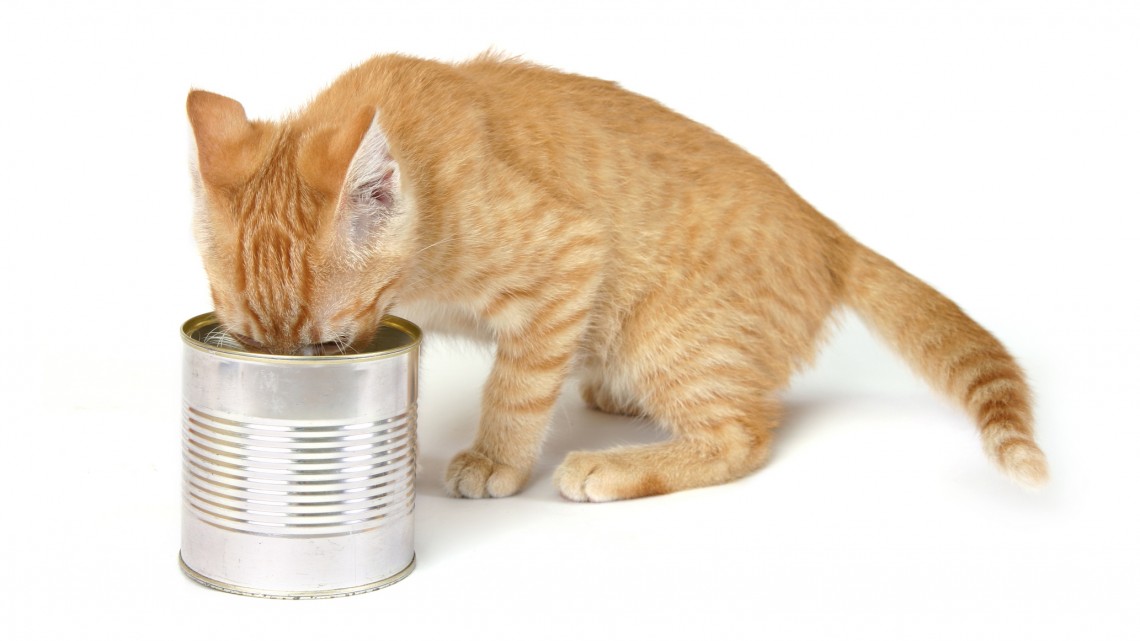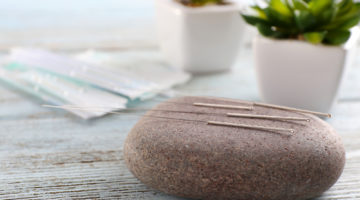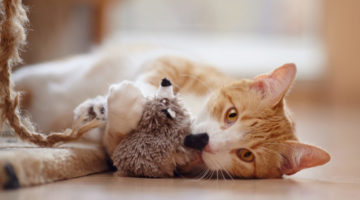Obesity among cats is a major problem. Trouble is, a lot of indoor kitties become chronically inactive if not given enough physical and mental stimulation. Check out these tips for encouraging your feline to jump off the couch (or counter) and get moving.
If your feline friend is on the heavy side, he’s got plenty of company. The Association for Pet Obesity Prevention claims that an astounding 51 million American cats are overweight and 15.8 million are estimated to be obese. The pejorative “fat cat” can just as easily apply to our feline family members as it does to Wall Street bankers. But unlike those bankers, no government bailout can help our corpulent kitties. It’s up to us to create a stimulus plan to help our cats lose weight.
Getting started
Before starting a weight loss plan for your cat, the first step is to consult your veterinarian. While feline obesity is a common problem, homeopathic veterinarian Dr. Christina Chambreau cautions animal guardians to remember that every cat is an individual. “Some need more exercise than others to live healthy and lead longer lives,” she says. “One way to know how healthy your cat is, and to know if the amount of exercise you are doing with him is enough, is to check for the early warning signs of illness.” Visit (christinachambreau.com) or the Academy for Veterinary Homeopathy (theavh. org) for a detailed listing of signals that your cat could be developing cardiovascular disease, musculoskeletal issues or even hypertension.
For those who may be worried about overdoing initial exercise sessions with their cats, Dr. Chambreau has reassuring advice: “Any illness and all health are made better by the proper degree of exercise for the individual animal. Rarely are people able to make a cat play too much. They’ll make dogs play too much, but not cats.”
It’s also important to consult your vet before reducing your cat’s caloric intake or making abrupt changes to his diet. Cats can get sick if they lose weight too quickly, or may develop gastrointestinal upset when their diets are changed. “It’s always best to offer cats a fresh food diet,” says Dr. Chambreau. “And the best real food for a cat is what makes up a mouse – raw meat, meaty bones and pureed vegetables.”
Look at his toys
Toys are the cornerstone of any feline exercise program, but it’s important to choose the right ones. In fact, any hazards associated with increased play may actually lie with the toys rather than the tempo. The most dangerous toy is the prototypical string of yarn. “With the way cats’ tongues work, it is almost impossible for them to spit anything out,” says Dr. Chambreau. “Cats that eat string, yarn, rubber bands, shoelaces or anything very thin run the risk of having those items block their intestines or get caught around the bases of their tongues.” Dr. Chambreau suggests making toys out of wider items like the sash of a bathrobe or a man’s old tie.
“You also have to think about what you are throwing on the floor for your cat to chase,” she adds. “Many cat guardians will roll up a small ball of aluminum foil, which makes great noise skittering across the floor, but the cat could easily swallow it. It would be much better to crumple up some paper, which will dissolve in the cat’s intestinal tract if he happens to eat it.”
Many purchased toys can be risky too. “Little things like sequins are often sewn onto toys, and many have parts like ears and tails that easily come off,” says Dr. Chambreau. Shop for quality made toys that have no removable parts, or substitute items like ping pong balls, water bottle lids, or leaves from celery or carrots.
“Once a cat reaches about two or three years old, he should maintain the same energy level and playfulness for the rest of his life.”
Whatever toys your cat likes best, schedule in a few short sessions of interactive play every day. Your cat is more likely to exercise if you play with him (toys that move are much more fun for him than toys that just lie on the floor). To prevent boredom, rotate to different toys on a regular basis. Rubbing them with dried catnip helps get your kitty more excited and willing to play.
For confirmed lazybones If you’ve tried every toy imaginable and still can’t tempt your cat off the couch, it’s time to get creative and do some experimenting.
- “If there is anything you know your cat would move toward, move her away from it and get her to exercise toward it,” suggests Dr. Chambreau. “For example, if your cat really loves her food, then make a game out of meal time. When it’s time to eat, take your cat to the opposite end of the house or up the stairs, and make it a race to dinner.”
- Similarly, if you notice your cat is excited by the doorbell (without nervousness or fear) ring it yourself and watch him come running. You can do the same with any noise that attracts his attention and curiosity, such as a treat package (be sure not to give him too many!) or a toy with a squeaker.
- Don’t run after your cat in an attempt to get her to exercise. “You never want to chase her in a threatening way,” says Dr. Chambeau. “It must always be a matter of enticing her.”
- Cat towers and condos allow felines to do a lot of climbing up and down. Most kitties love them.
- Many cats like to leap in and out of cardboard boxes.
Healthy cats do not “get old.” “Once a cat reaches about two or three years old, he should maintain the same energy level and playfulness for the rest of his life,” says Dr. Chambreau. So never fall back on the excuse that your cat is too old for play!







No Comment